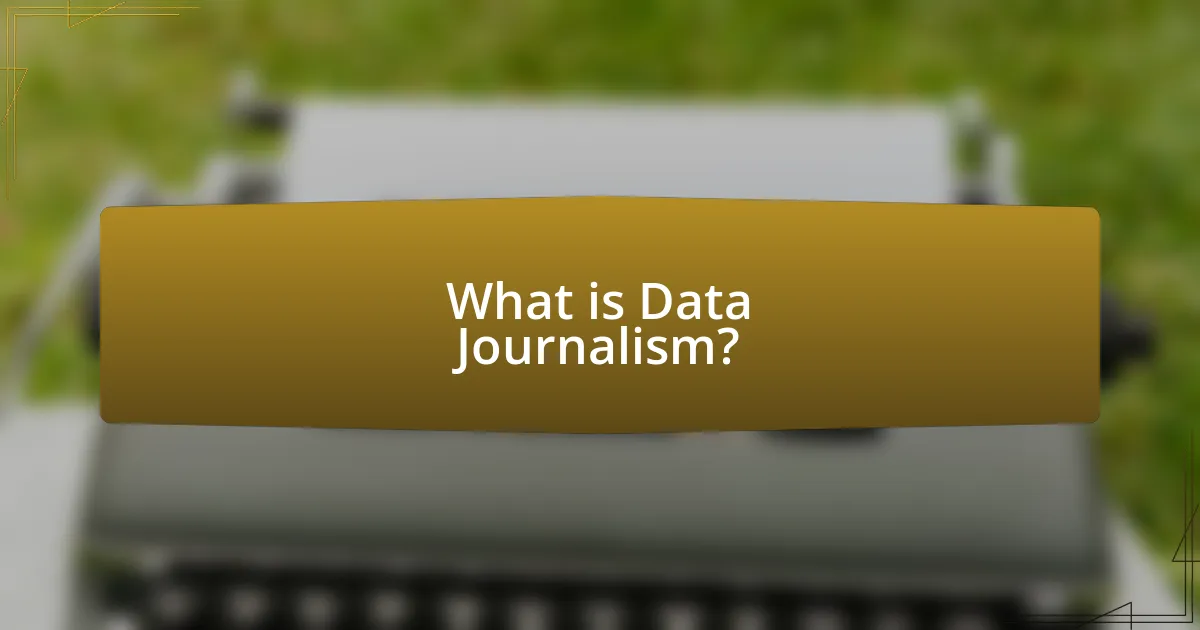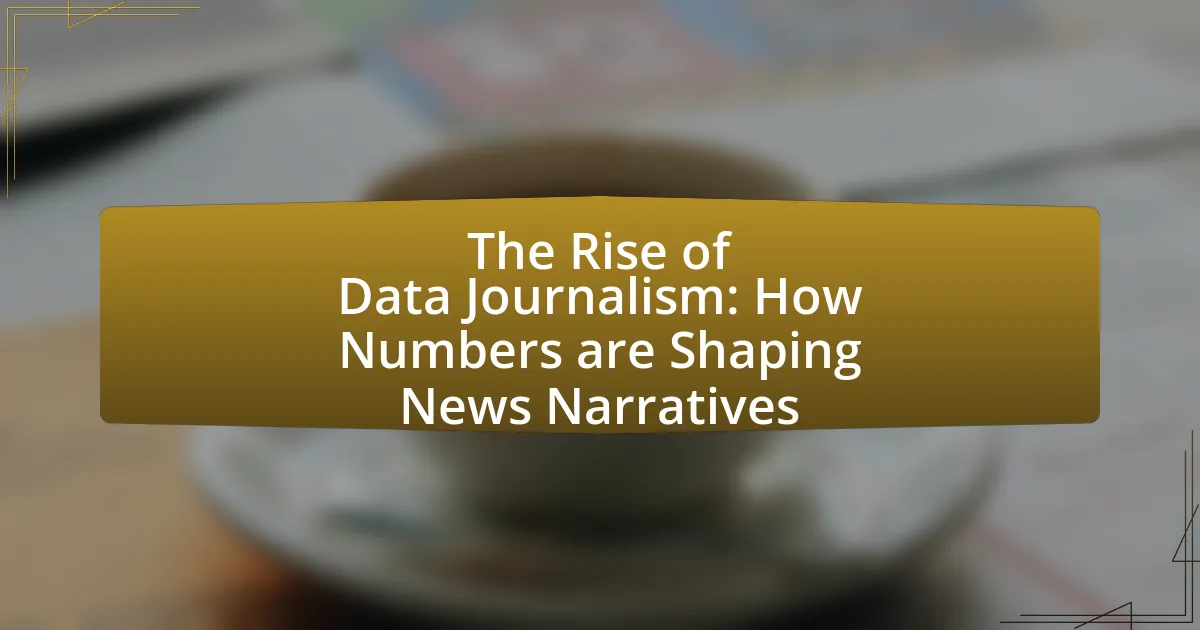Data journalism is the practice of utilizing data as a primary source for news reporting, involving the collection, analysis, and visualization of data to uncover trends and insights. This article explores the evolution of data journalism, highlighting its historical context, technological advancements, and the importance of data-driven narratives in today’s media landscape. It discusses the role of data journalism in enhancing transparency, informing public discourse, and the challenges journalists face, such as data accessibility and misinterpretation. Additionally, the article examines the impact of artificial intelligence on data journalism, essential skills for aspiring data journalists, and best practices for reporting with data.

What is Data Journalism?
Data journalism is the practice of using data as a primary source for reporting news stories. This approach involves collecting, analyzing, and visualizing data to uncover trends, patterns, and insights that inform public discourse. For instance, the use of data in journalism has been pivotal in investigative reporting, such as the analysis of financial records in the Panama Papers, which revealed widespread tax evasion among global elites. This demonstrates how data journalism not only enhances storytelling but also holds power accountable through evidence-based reporting.
How has Data Journalism evolved over time?
Data journalism has evolved significantly from its inception in the early 2000s to the present day, transitioning from simple data reporting to a sophisticated field that integrates advanced analytics and visualization techniques. Initially, data journalism focused on basic data collection and presentation, often relying on spreadsheets and static charts. As technology advanced, journalists began utilizing tools like SQL, Python, and R for deeper data analysis, enabling them to uncover complex stories hidden within large datasets.
The rise of interactive visualizations and infographics has further transformed data journalism, allowing audiences to engage with data in more meaningful ways. For instance, the New York Times and The Guardian have pioneered interactive storytelling, enhancing reader comprehension and engagement. According to a 2021 Pew Research Center study, 63% of journalists now use data analysis in their reporting, highlighting the growing importance of data-driven narratives in modern journalism.
This evolution reflects a broader trend in media where data literacy is increasingly essential for journalists, enabling them to provide context and insight into societal issues through quantitative evidence.
What historical events contributed to the rise of Data Journalism?
The rise of Data Journalism was significantly influenced by the advent of the internet and the digital revolution in the late 20th century. The proliferation of online data sources and the ability to analyze large datasets transformed how journalists gather and present information. For instance, the launch of Google in 1998 and the subsequent development of data visualization tools enabled journalists to access and interpret complex data more effectively. Additionally, the 2008 financial crisis highlighted the need for transparency and accountability in reporting, prompting media organizations to adopt data-driven approaches to investigate and explain economic issues. These events collectively fostered an environment where data became integral to storytelling in journalism.
How have technological advancements influenced Data Journalism?
Technological advancements have significantly influenced data journalism by enhancing data collection, analysis, and visualization capabilities. The proliferation of big data technologies allows journalists to access vast datasets, enabling more comprehensive and accurate reporting. For instance, tools like Tableau and Google Data Studio facilitate the visualization of complex data, making it easier for audiences to understand trends and insights. Additionally, advancements in machine learning and artificial intelligence enable automated data analysis, allowing journalists to uncover patterns and correlations that would be difficult to detect manually. These technologies have transformed data journalism from a niche practice into a mainstream approach, as evidenced by the increasing number of news organizations employing data journalists and integrating data-driven stories into their reporting.
Why is Data Journalism important in today’s media landscape?
Data journalism is important in today’s media landscape because it enhances the credibility and depth of news reporting by providing empirical evidence to support claims. In an era where misinformation is rampant, data journalism allows journalists to analyze and present complex information in a clear and accessible manner, thereby fostering informed public discourse. For instance, a study by the Pew Research Center found that 63% of Americans believe that data-driven reporting helps them understand issues better. This reliance on data not only strengthens journalistic integrity but also engages audiences by transforming raw statistics into compelling narratives that highlight societal trends and issues.
What role does Data Journalism play in enhancing transparency?
Data journalism plays a crucial role in enhancing transparency by providing evidence-based reporting that allows the public to scrutinize information critically. By utilizing data analysis, journalists can uncover patterns, trends, and anomalies that may not be visible through traditional reporting methods. For instance, investigations into government spending or public health data can reveal discrepancies and hold authorities accountable, as seen in the reporting on the COVID-19 pandemic where data visualizations helped clarify the impact of policies. This approach not only informs the public but also fosters trust in media by demonstrating a commitment to factual accuracy and accountability.
How does Data Journalism contribute to informed public discourse?
Data journalism contributes to informed public discourse by providing evidence-based insights that enhance understanding of complex issues. By utilizing data analysis, journalists can uncover trends, patterns, and correlations that inform citizens about societal challenges, such as economic inequality or public health crises. For instance, a study by the Pew Research Center found that data-driven reporting significantly increases audience engagement and trust, as it allows readers to see the factual basis behind news stories. This transparency fosters a more informed electorate capable of making decisions based on accurate information rather than misinformation or opinion.

How are Numbers Shaping News Narratives?
Numbers shape news narratives by providing quantifiable evidence that enhances storytelling and informs public understanding. Data journalism utilizes statistics, charts, and graphs to present complex information in an accessible format, allowing audiences to grasp trends and patterns. For instance, during the COVID-19 pandemic, news outlets relied heavily on numerical data to report infection rates, vaccination progress, and economic impacts, which helped contextualize the crisis for the public. This reliance on numbers not only adds credibility to news stories but also influences public opinion and policy decisions by highlighting significant issues through a factual lens.
What techniques do journalists use to incorporate data into storytelling?
Journalists use several techniques to incorporate data into storytelling, including data visualization, statistical analysis, and narrative framing. Data visualization, such as charts and infographics, helps to present complex information in an accessible format, making it easier for audiences to understand trends and patterns. Statistical analysis allows journalists to interpret data accurately, providing context and significance to the numbers presented. Narrative framing involves integrating data within a compelling story structure, ensuring that the data supports the overall narrative and engages the audience emotionally. These techniques enhance the credibility and impact of news stories, as evidenced by the increasing reliance on data-driven reporting in major publications like The New York Times and The Guardian, which frequently utilize these methods to inform and engage their readers.
How do visualizations enhance the understanding of data in news?
Visualizations enhance the understanding of data in news by transforming complex information into accessible formats that facilitate quick comprehension. They allow readers to grasp trends, patterns, and relationships within data that might be obscured in textual descriptions. For instance, a study by the Pew Research Center found that articles with visual elements, such as charts and graphs, are 50% more likely to be shared on social media, indicating that visualizations not only aid understanding but also increase engagement. This effectiveness stems from the human brain’s ability to process visual information 60,000 times faster than text, making visualizations a crucial tool in data journalism for conveying important narratives succinctly and effectively.
What are the common sources of data used in journalism?
Common sources of data used in journalism include government reports, academic studies, public records, surveys, and databases. Government reports provide official statistics and insights on various issues, while academic studies offer peer-reviewed research that can inform news narratives. Public records, such as court documents and property records, serve as primary sources for investigative journalism. Surveys conducted by reputable organizations yield quantitative data on public opinion and trends. Additionally, databases like those maintained by non-profit organizations or research institutions compile extensive datasets that journalists can analyze for stories. These sources collectively enhance the credibility and depth of journalistic reporting.
What challenges do journalists face when using data?
Journalists face several challenges when using data, including data accessibility, data literacy, and data interpretation. Data accessibility can be limited due to paywalls, proprietary databases, or lack of public datasets, which restricts journalists’ ability to obtain necessary information. Data literacy is another significant challenge, as not all journalists possess the skills to analyze and interpret complex datasets accurately, leading to potential misrepresentation of information. Furthermore, data interpretation can be complicated by biases in data collection methods or the context in which data is presented, which can skew the narrative. These challenges highlight the need for ongoing training and resources to enhance journalists’ capabilities in data journalism.
How can data misinterpretation affect news narratives?
Data misinterpretation can significantly distort news narratives by leading to inaccurate conclusions and misleading representations of facts. When journalists misinterpret data, they may present skewed statistics or cherry-picked information that supports a particular agenda, which can misinform the public. For example, a study by the Pew Research Center found that 62% of Americans believe that news organizations often report stories inaccurately, highlighting the impact of misrepresented data on public trust. This misrepresentation can create polarized opinions and shape societal perceptions based on flawed information, ultimately influencing policy decisions and public discourse.
What ethical considerations must journalists keep in mind when reporting data?
Journalists must prioritize accuracy, transparency, and context when reporting data. Accuracy ensures that the data presented is correct and reliable, as misinformation can lead to public misunderstanding and harm. Transparency involves disclosing the sources of data and methodologies used in analysis, which builds trust with the audience. Context is crucial, as presenting data without adequate background can mislead readers; for instance, statistics can be manipulated to support biased narratives. Ethical guidelines from organizations like the Society of Professional Journalists emphasize these principles, reinforcing the responsibility of journalists to uphold integrity in data reporting.

What are the Future Trends in Data Journalism?
Future trends in data journalism include increased use of artificial intelligence for data analysis, enhanced visualization techniques, and a greater emphasis on transparency and ethics. Artificial intelligence is expected to streamline data processing, allowing journalists to uncover insights more efficiently. Enhanced visualization techniques, such as interactive graphics and immersive storytelling, will help audiences better understand complex data. Furthermore, as data journalism evolves, there will be a stronger focus on ethical considerations, ensuring that data is used responsibly and accurately to maintain public trust. These trends are supported by the growing demand for data-driven narratives in media, as evidenced by the rise of platforms dedicated to data journalism and the increasing integration of data analysis in traditional newsrooms.
How is artificial intelligence impacting Data Journalism?
Artificial intelligence is significantly transforming data journalism by enhancing data analysis, automating reporting processes, and improving audience engagement. AI tools enable journalists to quickly analyze large datasets, uncover patterns, and generate insights that would be time-consuming to identify manually. For instance, natural language processing algorithms can automatically summarize complex data into digestible narratives, allowing journalists to focus on storytelling rather than data crunching. Additionally, AI-driven platforms can personalize content for readers, tailoring news articles based on user preferences and behaviors, which increases engagement and relevance. According to a report by the Reuters Institute for the Study of Journalism, 63% of journalists believe AI will play a crucial role in the future of news production, highlighting its growing importance in the field.
What are the potential benefits of AI in data analysis for journalism?
AI enhances data analysis in journalism by increasing efficiency, accuracy, and the ability to uncover insights from large datasets. By automating data processing, AI allows journalists to analyze vast amounts of information quickly, leading to faster story development. For instance, AI algorithms can identify trends and patterns that may not be immediately visible to human analysts, enabling journalists to generate data-driven narratives. Additionally, AI tools can assist in fact-checking and verifying information, which improves the credibility of news reports. According to a 2020 report by the Reuters Institute for the Study of Journalism, 63% of journalists believe that AI will significantly impact their work, highlighting its growing importance in the field.
What risks does AI pose to the integrity of Data Journalism?
AI poses significant risks to the integrity of Data Journalism by potentially introducing biases, misinformation, and a lack of accountability. Algorithms used in AI can perpetuate existing biases present in training data, leading to skewed reporting and misrepresentation of facts. For instance, a study by ProPublica in 2016 highlighted how predictive policing algorithms disproportionately targeted minority communities, illustrating how biased data can influence journalistic narratives. Furthermore, AI-generated content can spread misinformation rapidly, as seen with deepfake technology, which can create realistic but false representations of events. This undermines trust in journalistic sources. Lastly, the reliance on AI tools may reduce human oversight, leading to a lack of accountability in reporting, as automated systems may not adhere to ethical journalism standards.
What skills are essential for aspiring data journalists?
Essential skills for aspiring data journalists include strong analytical abilities, proficiency in data visualization tools, and solid writing skills. Analytical abilities enable journalists to interpret complex datasets, while proficiency in tools like Tableau or Excel allows for effective presentation of data insights. Additionally, strong writing skills are crucial for translating data findings into compelling narratives that engage readers. According to a 2021 report by the American Press Institute, data-driven storytelling significantly enhances audience engagement, underscoring the importance of these skills in the evolving landscape of journalism.
How can journalists improve their data literacy?
Journalists can improve their data literacy by engaging in targeted training programs that focus on data analysis, visualization, and interpretation. These programs often include workshops and online courses that teach essential skills such as statistical analysis, the use of data visualization tools like Tableau or Excel, and understanding data ethics. For instance, the Knight Center for Journalism in the Americas offers courses specifically designed to enhance journalists’ data skills, which have been shown to significantly increase their confidence and ability to work with data in reporting. Additionally, collaborating with data scientists and attending data journalism conferences can provide practical insights and networking opportunities that further enhance data literacy.
What tools and software are recommended for data analysis in journalism?
Recommended tools and software for data analysis in journalism include Excel, Google Sheets, Tableau, R, and Python. Excel and Google Sheets are widely used for basic data manipulation and visualization due to their accessibility and user-friendly interfaces. Tableau is favored for its powerful data visualization capabilities, allowing journalists to create interactive graphics. R and Python are programming languages that offer advanced statistical analysis and data manipulation, making them suitable for in-depth data journalism projects. These tools are essential for journalists to analyze data effectively and present findings in a compelling manner.
What best practices should journalists follow when reporting with data?
Journalists should ensure accuracy, transparency, and context when reporting with data. Accuracy involves verifying data sources and ensuring that statistics are correctly interpreted; for instance, a study by the Pew Research Center found that 62% of Americans believe that news organizations should prioritize accuracy over speed. Transparency requires journalists to disclose their data sources and methodologies, allowing readers to assess the reliability of the information. Context is crucial, as presenting data without background can lead to misinterpretation; for example, a statistic showing a rise in crime rates should include context about population changes or economic factors. By adhering to these best practices, journalists can enhance the credibility and clarity of their data-driven stories.

Leave a Reply